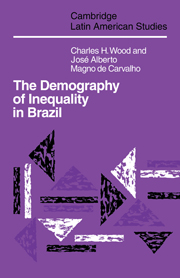Book contents
- Frontmatter
- Contents
- Illustrations
- List of tables
- Preface
- 1 Introduction
- 2 Framework for the study of population, development and inequality
- 3 Growth and distribution in historical perspective
- 4 Income inequality and length of life
- 5 Wage policy, infant mortality and collective social action in São Paulo
- 6 Racial inequality and child mortality
- 7 The “baby bust”
- 8 Income distribution and population growth
- 9 Agrarian structure and the rural exodus
- 10 Colonization and frontier expansion in Amazônia
- 11 Development and persistent underemployment
- 12 The demography of inequality in Brazil: summary and conclusion
- Appendix: A note on method
- Notes
- Bibliography
- Index
- CAMBRIDGE LATIN AMERICAN STUDIES
6 - Racial inequality and child mortality
Published online by Cambridge University Press: 04 August 2010
- Frontmatter
- Contents
- Illustrations
- List of tables
- Preface
- 1 Introduction
- 2 Framework for the study of population, development and inequality
- 3 Growth and distribution in historical perspective
- 4 Income inequality and length of life
- 5 Wage policy, infant mortality and collective social action in São Paulo
- 6 Racial inequality and child mortality
- 7 The “baby bust”
- 8 Income distribution and population growth
- 9 Agrarian structure and the rural exodus
- 10 Colonization and frontier expansion in Amazônia
- 11 Development and persistent underemployment
- 12 The demography of inequality in Brazil: summary and conclusion
- Appendix: A note on method
- Notes
- Bibliography
- Index
- CAMBRIDGE LATIN AMERICAN STUDIES
Summary
On his return from a hunting trip to South America in the early 1900s, Theodore Roosevelt noted what he understood to be a fundamental difference between Brazil and the United States. “If I were asked to name one point in which there is a complete difference between the Brazilians and ourselves,” Roosevelt proclaimed, “I should say it was in the attitude to the black man … In Brazil any Negro or mulatto who shows himself fit is without question given the place to which his abilities entitle him” (cited in Silva 1978: 50).
Roosevelt's comment echoed a common and today still popular theme: that, unlike the United States, or other countries such as South Africa, Brazil is a “racial democracy.” The racial democracy thesis implies two corollaries essential for understanding the dominant perception of race relations in Brazil. The first corollary concerns the relationship between race, class and prejudice. According to the prevalent notion, if white Brazilians take a dim view of the black and brown population, it is because most nonwhites are lower class. Prejudice, if it exists at all, does not involve racism or racial discrimination, so much as personal prejudice against low status.
The “class over racism” explanation for prejudice was put forth by Donald Pierson (1967), who wrote Negroes in Brazil: the History of Race Contact in Brazil: and by the Bahian social scientist Thales de Azevedo (1953).
- Type
- Chapter
- Information
- The Demography of Inequality in Brazil , pp. 135 - 153Publisher: Cambridge University PressPrint publication year: 1988
- 1
- Cited by



